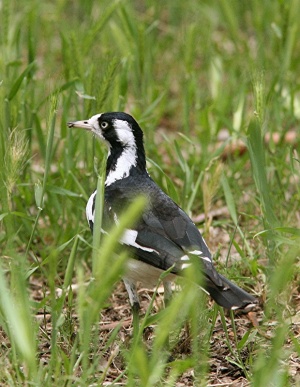Alternative names: Australian Magpie-lark; Little Magpie; Murray Magpie; Mudlark; Pied Grallina
- Grallina cyanoleuca
Identification
25 - 30cm (9¾-11¾ in). A common to abundant passerine of Australia:
Male
- Broad white line above eye
- Large white patch from ear-coverts down to side of neck
- Glossy black rest of head, throat and upper breast
- Glossy black hindneck to rump
- White uppertail coverts and tail (with broad black subterminal area)
- Black upperwing, most of secondary wing-coverts white
- White underparts below breast
- Ivory-coloured to creamy bill with blackish nasal groove
- Dark bluish-grey to blackish legs
Female
- White forehead and throat
- Broad black band from crown down side of face to chest, behind this a broad white area from the eye down to the shoulder, meeting the white underparts
Juveniles have a mixed appearance between males and females with a black crown, a white stripe above the eye, a white throat and a white area from the eye to the shoulder.
Distribution
Found in Australia (except Tasmania and dry interior of Western Australia), extreme southern New Guinea, and Timor. Introduced on Lord Howe Island.
Common to abundant in its range. Introductions in New Zealand, Hawaii and in Fiji failed.
Taxonomy
Subspecies
There are two subspecies[1]:
- G. c. neglecta:
- Northern Australia, extreme southern New Guinea and Timor
- G. c. cyanoleuca:
- Mainland Australia, except north and the most arid areas
Habitat
Widespread but is absent from deep forest; common in urban areas. Needs mud and water for nest building.
Occurs from the lowlands up to 1000m, occasionally higher.
Behaviour
Usually seen singly or in pairs. Young birds can form bigger groups.
Diet
Feeds mainly on invertebrates (like spiders, worms, insects and crustaceans), takes also small frogs and sometimes some seeds. Mainly foraging on the ground, walking or wading in muddy margins.
Breeding
Breeding season related to rainfall and availability of mud for nest construction. A monogamous species, pairs stay together several years. The nest is an open cup made of plant material plastered with mud and lined with grass, feathers and fur. It's placed on a flat branch, usually near water. Lays 1 - 6 eggs. Pallid Cuckoo, Australian Koel and Channel-billed Cuckoo are reported to parasitize this species.
Movements
Mainly a resident species, partly migratory in some parts of its range.
Gallery
Click on photo for larger image
Dis-used nest
Photo © by Delia Todd
Bowra Sanctuary Back Dam, Cunnamulla, Queensland, 7 September 2019
References
- Clements, J. F., T. S. Schulenberg, M. J. Iliff, S. M. Billerman, T. A. Fredericks, B. L. Sullivan, and C. L. Wood. 2019. The eBird/Clements Checklist of Birds of the World: v2019. Downloaded from http://www.birds.cornell.edu/clementschecklist/download/
- Del Hoyo, J, A Elliott, and D Christie, eds. 2009. Handbook of the Birds of the World. Volume 14: Bush-shrikes to Old World Sparrows. Barcelona: Lynx Edicions. ISBN 978-8496553507
- Simpson, K and N Day. 1998. Field Guide to the Birds of Australia. London: Christopher Helm. ISBN 0-7136-4877-5
Recommended Citation
- BirdForum Opus contributors. (2025) Magpie-lark. In: BirdForum, the forum for wild birds and birding. Retrieved 12 May 2025 from https://www.birdforum.net/opus/Magpie-lark
External Links
GSearch checked for 2020 platform.








